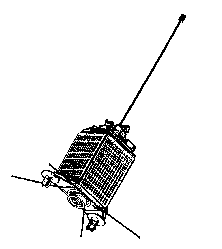 Spotlight On: UoSAT-OSCAR-11
Spotlight On: UoSAT-OSCAR-11
By: John A. Magliacane, KD2BD
[This article originally appeared in The AMSAT Journal, Volume 15
No. 1, January/February 1992]
SPECS:
Name: UO-ll aka UoSAT-2
Object # 14781
Launch: 1 March 1984
Period: 99 Minutes
Increment: 24.6 degrees west per orbit
Orbit: Polar LEO (Low Earth Orbit)
Altitude: 680 km (423 miles) average
Dimensions: 58.5 cm (23 in)
35.5 cm (14 in)
35.5 cm (14 in)
Weight: 60 kg (132 lbs)
Telemetry: 1200 bps FM AFSK
Downlink: 145.825 MHz (most common)
435.025 MHz
2401.5 MHz
Imagine... It's March, 1988. You're part of a skiing expedition across the North Pole. Your team's position is calculated through a COSPAS network and relayed to the University of Surrey where OSCAR-11's Digitalker is programmed to reflect your daily positions. Finding your location is as easy as turning on your 2-meter handheld! Daily updates carried on OSCAR-11 help you and your team navigate despite the brutal Arctic conditions.
A massive solar flare disrupts all HF skywave propagation. WWV can't be heard. As OSCAR-11 comes into range, you capture whole orbit telemetry data from the spacecraft and plot the information graphically on your computer. Radiation counts over the poles have increase dramatically. Space dust counts have skyrocketted along with radiation induce RAM errors. OSCAR-11 keeps you abreast of the progress of the event as it circles the globe gathering more important information.
A packet message you've received half a world away demands a rapid reply. Quickly you fire off a response and direct it through your closest OSCAR-11 DCE Gateway station. Your mail message is relayed through OSCAR-11 and arrives at its destination within hours, without the use of HF gateways. OSCAR-11 provides that important communications link.
You are called away on business to a place where no VHF packet activity exists. You pack a 2-meter handheld, a small antenna, and a UoSAT demodulator along with your laptop. Weekly news bulletins received through OSCAR-11 keep you informed on the latest happenings in the Amateur Satellite program regardless of where you are in the world.
UoSAT-OSCAR-11 was launched from the Western Test Range at Vandenberg Air Base, in Lompoc, California along with LANDSAT-5 on a Delta 3920 rocket on March 1, 1984. OSCAR-11 is the most rapidly designed OSCAR, going from inception to launch in only five months! OSCAR-11 is also the first amateur satellite to carry a digital communications package into Earth orbit, and the first to be controlled by a CPU running software written in the high-level programming language "Forth."
Unlike most OSCAR satellites, UoSAT-OSCAR-11 does not contain real-time communications transponders. Instead, it beacons downlink a wealth of information concerning the "near-Earth" environment in a variety of formats. There's "Digitalker" speech synthesizer on-board capable of transmitting telemetry data and pre-programmed messages in plain English using either "American" or "English" accents, a charged coupled device (CCD) Earth imaging camera capable of providing 384x256 pixel resolution digitized to a 7 bit gray scale, space dust impact detectors, Geiger counters, and a Digital Communications Experiment (DCE) for handling electronic mail on a store-and-forward basis between groundstations on Earth.
UoSAT-OSCAR-11 carries three beacon transmitters that are easily heard using simple groundstation equipment. The VHF beacon carries Audio Frequency Shift Keying (AFSK) at 1200 baud plus analog voice messages all on a single narrow-band FM carrier frequency of 145.826 MHz. The UHF beacon is capable of producing either AFSK-FM or high-speed PSK on a carrier frequency of 435.025 MHz. This beacon is most often used to downlink information from the Digital Store and Readout (DSR) Experiment at 4800 baud, which includes CCD Earth image data, results from the Particle Wave Experiment, and engineering data from the RCA COSMAC 1802 CPU. The SHF beacon is the least used, but can sometimes be heard transmitting FM and PSK signals on a carrier frequency of 2401.5 MHz. Antenna polarization for all three beacon transmitters is left-hand circular (LHCP).
Telemetry and news bulletins transmitted by OSCAR-11 are sent using phase synchronous audio frequency shift keying on a narrow-band FM carrier with AFSK tones of 1200 Hz (logic "0") and 2400 Hz (logic "1") and a data rate of 1200 bps. This modulation format permits synchronous AFSK demodulation and post detection correlation decoding, making weak signal detection possible with a minimum of data errors. Most UoSAT demodulators, however, are simple PLL designs that work well under noise-free reception conditions.
The current schedule of OSCAR-11 operations is as follows:
145.826 MHz:
From 00:00 Thursday to 23:59 Tuesday (UTC)
ASCII Telemetry 45 seconds
ASCII Status Message 15 seconds
Binary Telemetry 30 seconds
ASCII Bulletin 90 seconds
Binary SEU Dump 30 seconds
Binary Engineering Frame 30 seconds
ASCII WOD 180 seconds
Binary WOD 120 seconds
Binary Telemetry 45 seconds
DCE Titles 60 seconds
-----------
TOTAL 645 seconds
From 00:00 to 13:59 Wednesday (UTC)
Binary Telemetry 45 seconds
ASCII Telemetry 150 seconds
ASCII Status Message 15 seconds
-----------
TOTAL 210 seconds
From 14:00 to 23:59 Wednesday (UTC)
ASCII WOD 120 seconds
ASCII Status Message 15 seconds
-----------
TOTAL 135 seconds
435.025 MHz:
From 00:00 to 12:00 Sunday (UTC):
4800 Baud DSR Data
From 06:00 to 14:00 Wednesday (UTC):
4800 Baud DSR Data
Because of power budget constraints, the 435.025 MHz transmitter is off
at all other times.This schedule is often interrupted during one AM (UTC) pass on weekdays (except Wednesday) for routine operations from the UoS Groundstation. During these operations, the downlink will be on 435.025 MHz 1200 baud and the VHF beacon will be off.
UoSAT-OSCAR-11 is in a low-altitude, circular, sun-synchronous Earth orbit. It can be received anywhere on the planet, several times a day. AMSAT-NA, Project OSCAR, and AMSAT-UK all carry OSCAR-11 telemetry decoding and analysis software, and there's more to come! OSCAR-11 telemetry analysis activities are very fascinating and offer a low-cost approach to Amateur satelliting. Give it a try! OSCAR-11 reception reports should be directed to the spacecraft controllers as follows:
UOSAT Spacecraft Engineering Research Unit
Department of Electrical Engineering
University of Surrey
Guildford, Surrey GU2 5XH
England